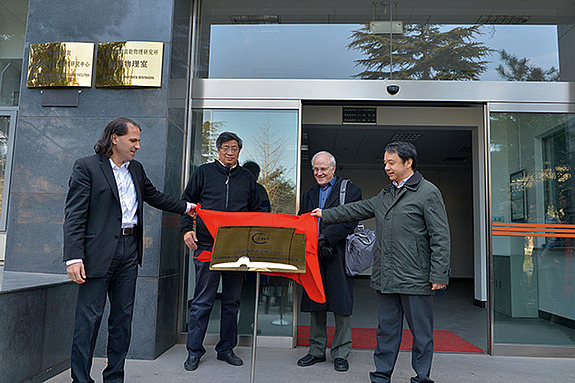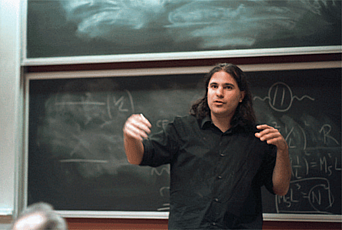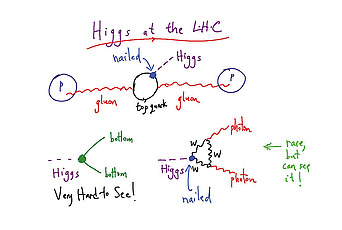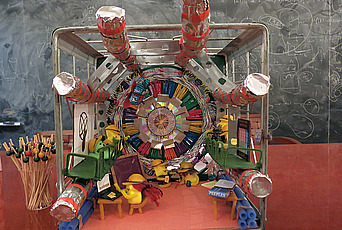Beyond the Higgs: From the LHC to China

Three years ago, just before it was scheduled to shut down in preparation for its second phase, the Large Hadron Collider (LHC) discovered the Higgs boson. Its discovery was expected, having been predicted nearly sixty years earlier by Peter Higgs, but the LHC-produced particle is bizarre and puzzling.
“There are all sorts of issues, theoretical issues surrounding the Higgs, which are very mysterious,” says Nima Arkani-Hamed, Professor in the School of Natural Sciences. “The Higgs is the first truly new kind of elementary particle that we have discovered in four decades, and it is really a strange object.” Point-like with no properties aside from a mass of 125 gigaelectronvolts (GeV), the Higgs particle does not have any charge or spin. It is also the only known particle with the ability to interact with itself.
Faced with such a compelling cliffhanger, Arkani-Hamed headed to China. “I thought the most effective thing I could do to push this part of physics forward is to try to make sure that the next machine happens,” says Arkani-Hamed. “I thought I could usefully engage a large pool of talent among young people who are experts in how all of these colliders work, who also were looking for something to do in the gap period between when the LHC shut off and turned on again.”
Arkani-Hamed joined forces with Yifang Wang, Director of the Institute of High Energy Physics in Beijing, and became the first Director of Beijing’s new Center for Future High Energy Physics. For the last two years, Arkani-Hamed has worked with Wang and others to articulate the case for building a Higgs factory known as the Circular Electron Positron Collider (CEPC), followed by a Super Proton Proton Collider (SPPC), a 50- to 100-kilometer-long circular collider outside of Beijing, which would provide a significant upgrade from the LHC’s 17-mile-long design.
Last year, Arkani-Hamed was in Beijing for roughly a week every month, working to finalize two reports (more than 700 pages altogether; see box for a link to the reports) that were submitted to the Chinese government this spring—making the physics argument for the colliders and describing how they would be built—with the aim of securing five-year funding for the project. If everything moves forward as proposed, the government’s approval of research-and-development funding for the next five years would be followed by the digging of a tunnel by 2020. Collision data from the Higgs factory would be available by the end of the decade.
The LHC turned back on in June at a recordbreaking 13 teraelectronvolts (TeV)—twice the energy level of the previous run, which allows for the possible discovery of particles that may have been at the edge of detectability (such as supersymmetric and/or dark matter particles). But this next run of the LHC won’t lead to a greater understanding of the Higgs, whose mass makes it difficult for the collider to obtain a very precise picture, even at its new energy.
The proposed CEPC would provide a microscope for studying the Higgs, particularly whether the Higgs might, after all, be a composite with some structure. “The really central question that we are interested in is: how point-like does it seem? If it had substructure, everything would be okay. If it had some discernible size, we would not freak out as theorists. We would understand. We would be happy,” says Arkani-Hamed. “But more and more, it looks like it doesn’t have substructure. You probe to shorter and shorter distances—it still seems to be completely featureless and the stranger and stranger things become. The LHC itself is only going to give us a pretty fuzzy picture of it.”
Most theoretical physicists, including Arkani-Hamed, believe there has to be something beyond the Higgs—either supersymmetric particles or other new particles that the LHC may discover as soon as the end of this year. “If we see something beyond the Higgs: spectacular,” says Arkani Hamed. “If we don’t see something beyond the Higgs: extremely disquieting, extremely weird. It throws down a big challenge to a theorist to try to figure out what to make of it.”
China is not the only entity interested in hosting the next-generation collider. The European Organization for Nuclear Research (CERN), which operates the LHC, is exploring the idea, as is Japan.
The Higgs boson explains how most fundamental particles acquire mass as they interact with a Higgs field that exists everywhere in the universe. It was the final element of the Standard Model that needed to be confirmed experimentally, and its discovery promises to provide further understanding of the origin of mass and help clarify some long-standing mysteries.
“Thinking about where the Higgs might come from, it starts getting very, very confusing,” says Arkani-Hamed. “Precisely how the field of particle physics will develop is going to depend an enormous amount on what we actually learn. Whatever we learn is going to throw the field down one road or another.”
The LHC is a proton-proton collider that produces the Higgs particle along with dozens of other particles. The proposed CEPC would collide electrons and positrons tuned to energies that would produce millions of Higgs particles in an extremely clean environment. This would lead to a more precise understanding of how Higgs particles are produced and how they decay. The CEPC would show how other particles interact with the Higgs and how point-like the particle looks to external probes.
The first phase would focus on these microscopic studies of the Higgs. The second phase would commence in about fifteen years and involve the building of the SPPC at energies of 100 TeV, a little more than seven times higher than the current energy level of the LHC. In addition to pushing the high-energy frontier, the SPPC would test how the Higgs interacts with itself and whether it interacts with itself in the way it would if it were truly point-like. (One reason for this fifteen-year timescale is that the stronger magnets, produced by Fermilab in the United States, which are needed to get to these incredibly high energies, will take that long to make.)
The physics community, particularly in the United States, still bruisingly recalls when Congress officially killed the U.S. effort to build a supercollider in 1993, transferring U.S. dominance in high-energy physics to Europe when it successfully built CERN’s LHC. When Arkani-Hamed first traveled to China to talk to Wang and others who are leading the effort to build the next-generation collider there, it quickly became obvious to him that they were very serious. “China brings to this entire discussion a certain level of newness. They are going to need help, but they have financial muscle and they have ambition,” says Arkani-Hamed. “It would be fantastic for physics to get them involved in this endeavor—a big-scale scientific project that China can do with guaranteed success: they build it and people come, no ifs, ands, or buts.”
The building of the proposed colliders would be a huge leap for China—to support it, the size of the Chinese physics community would need to increase dramatically. As Director of the Center for Future High Energy Physics, Arkani-Hamed recruited forty to fifty of his closest friends and colleagues to come to Beijing, study the physics potential of these machines, give lectures, interact with the Chinese physics community, and “start trying to drum up excitement and enthusiasm for the whole project, not just in China, but around the world.”
If the project moves forward, Arkani-Hamed envisions being involved at an educational level, helping to develop an international program where fundamental physics is introduced to undergraduate sophomores and perhaps rotates between China, Fermilab, and CERN.
“It is extremely interesting to think about getting sophomores up to the speed of a second-year graduate student. I think it is possible,” says Arkani- Hamed. “The scale is going to have to be huge. We are talking about hundreds of people involved in programs like this.”
Driving Arkani-Hamed is the sense that physics is on the threshold of a new, eye-opening era. In the film Particle Fever, Arkani-Hamed and physicist Savas Dimopoulos are positioned as supporters of two distinct theories—multiverse (Arkani-Hamed) versus supersymmetry (Dimopoulos)—but a decade ago the two wrote a paper together that suggested a theory in between that fits very well with a Higgs that has the mass of 125 GeV discovered by the LHC.
“Like everyone in the field, I care about this physics a lot,” says Arkani-Hamed. “There was a period where it made a lot of sense for theorists to hypothesize and theorize a lot, and I did more than my share of that and people are continuing to do it. I personally transitioned away from that momentarily, because we are just about to find out whether the answer to some of these questions is roughly along the lines of what we expected. I am waiting on pins and needles.”
Recommended Reading: Copies of the reports—making the physics argument for the colliders and describing how they would be built—submitted to the Chinese government are available at http://cepc.ihep.ac.cn/preCDR/volume.html.


